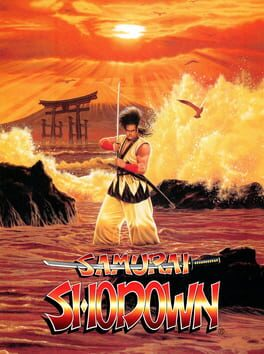▲
1
▼
The Sega CD version of the game contains a hidden message:
"r en rar politik!
Carl-Henrik 1995
JVC SUXX!!!!"
"Carl-Henrik" is programmer Carl-Henrik Skarstedt. The message implies that he was not happy with the ports publisher, JVC.
"r en rar politik!
Carl-Henrik 1995
JVC SUXX!!!!"
"Carl-Henrik" is programmer Carl-Henrik Skarstedt. The message implies that he was not happy with the ports publisher, JVC.
▲
1
▼
Adachi was originally going to make another ninja character that was very similar to Hanzo Hattori's design. However, because his wife was a fan of the 1987 manga Animal Doctor, he wanted to make a character that would be popular with the female market. Galford's character was inspired by the main character, Masaki Nishine, and his pet Siberian Husky, Chobi.
▲
1
▼
The idea for the Ikari gauge (renamed the POW bar in the Western release) was inspired by a Street Fighter II match that background designer Tomoki Fukui had with series creator Yasushi Adachi.
"Adachi came up with the idea, but the inspiration for the Ikari gauge came when the dev team was all playing Street Fighter 2 together for research purposes. Adachi and I were playing against each other and I frustrated him because I won. Adachi was so mad because he lost that he was silent for a minute. Then, he suddenly got up and shouted “Ikari gauge!” So we took that frustration, that anger and rage that players feel when they lose a battle, and decided to incorporate it into the game. That was where the inspiration for the Ikari gauge came from."
"Adachi came up with the idea, but the inspiration for the Ikari gauge came when the dev team was all playing Street Fighter 2 together for research purposes. Adachi and I were playing against each other and I frustrated him because I won. Adachi was so mad because he lost that he was silent for a minute. Then, he suddenly got up and shouted “Ikari gauge!” So we took that frustration, that anger and rage that players feel when they lose a battle, and decided to incorporate it into the game. That was where the inspiration for the Ikari gauge came from."
▲
1
▼
The game was designed to illustrate the terror of fighting weapon-to-weapon and the impact of fighting with a sword. Thus, being hit by a weapon does significant damage to the opposing player. This punishing difficulty faced criticism during the game's development. As noted by series creator Yasushi Adachi:
"There was a lot of internal criticism about deducting so much life gauge with one attack. SNK management said this design had to be changed, but I thought it was very interesting to have players fight under the risk and fear of fighting with weapons and feel the destructive force of the sword, so I ignored them and kept it in the game."
"There was a lot of internal criticism about deducting so much life gauge with one attack. SNK management said this design had to be changed, but I thought it was very interesting to have players fight under the risk and fear of fighting with weapons and feel the destructive force of the sword, so I ignored them and kept it in the game."
▲
1
▼
Gen-An's character was inspired by Johnny Depp's titular character from the Tim Burton film Edward Scissorhands. When asked why Gen-An became a green, hunchbacked character instead of more resembling Depp, series creator Yasushi Adachi replied: "I think you’ll agree with me on this, but Genan is more handsome than Johnny Depp. [Laughs]"
▲
1
▼
According to Yasushi Adachi, the original idea for the game was a side-scrolling action game with various monsters. When considering what would appeal to a global audience while creating the concept for a monster game, he "ultimately felt that a fighting game with ninjas and samurais, which represented distinctly Japanese characters, would do better than just monsters", and changed the concept accordingly. Gen-An Shiranui is the only surviving character from the initial concept.
▲
1
▼
Mai Shiranui from Fatal Fury makes a cameo appearance in Gen-An's ending as his final opponent Spoiler:to which Gen-An immediately dies from one blow.
▲
1
▼
Haohmaru and Ukyo are based on historical figures Musashi Miyamoto and Kojiro Sasaki from Sengoku era Japan, respectively. Nicotine is likely based on the Buddhist monk Takuan from the same era.
Related Games
Samurai Shodown II
Samurai Shodown
Samurai Shodown Anthology
Samurai Shodown III
Samurai Shodown 64
SNK vs. Capcom: SVC Chaos
Capcom vs. SNK 2: Mark of the Millennium 2001
Capcom vs. SNK: Millennium Fight 2000
Art of Fighting 3: The Path of The Warrior
Street Fighter 2010: The Final Fight
Transformers: Mystery of Comvoy
The Last Blade 2
Enemy Zero
Earthworm Jim
Legacy of Kain: Soul Reaver
Sonic & Sega All-Stars Racing
WarTech: Senko no Ronde
The King of Fighters '94
Sonic Rush Adventure
Alisia Dragoon
Mega Man 6
Pilotwings 64
Kirby's Pinball Land
Super Mario World
Koudelka
Streets of Rage
James Pond 2: Codename - RoboCod
Comix Zone
Sonic the Hedgehog 4: Episode I
Mortal Kombat
Ecco the Dolphin
Soul Hackers 2
Rock n' Roll Racing
Kirby's Block Ball
Space Channel 5: Part 2
Donkey Kong Land 2
SNK Heroines: Tag Team Frenzy
Pandemonium!
Donkey Kong
Worms 3D
Virtua Fighter 3
Sonic Adventure 2
Mighty Morphin Power Rangers: The Movie
Sonic Adventure DX: Director's Cut
Sonic Jam
Persona 5
Disney's Toy Story
Maimai DX Splash Plus
Dr. Mario
Fido Dido

